The Main Street in Little Falls, N.Y. , circa 1955 -1965
My Recollections by Allen Kazmerski
 My father told the story, many times, of how when he was a little boy, his mother had to hold his hand tightly when they made their way downtown to do their shopping on Main Street in Little Falls. The necessity of holding hands was predicated on the fear of losing him in the bustling crowds walking to and from their shopping destinations. The time was the mid-to-late 1920s. Little Falls was nearing its peak population of around 13,000, and all 13,000 did their shopping locally, as the local merchants supplied everything one could need. The trolley car trundled their passengers in a loop down Main Street, to John Street (currently the Route 5 EW arterial) and back to Main in a time when the horse and buggy still competed with the automobile as the favorite mode of transportation.
My father told the story, many times, of how when he was a little boy, his mother had to hold his hand tightly when they made their way downtown to do their shopping on Main Street in Little Falls. The necessity of holding hands was predicated on the fear of losing him in the bustling crowds walking to and from their shopping destinations. The time was the mid-to-late 1920s. Little Falls was nearing its peak population of around 13,000, and all 13,000 did their shopping locally, as the local merchants supplied everything one could need. The trolley car trundled their passengers in a loop down Main Street, to John Street (currently the Route 5 EW arterial) and back to Main in a time when the horse and buggy still competed with the automobile as the favorite mode of transportation.
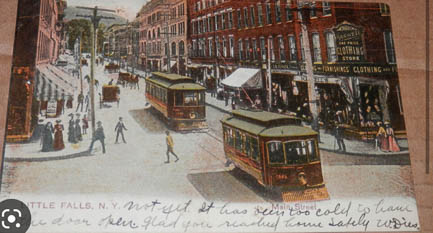
Little Falls Trolley – photo likely taken around 1910
Jumping forward to the general period concerning this article, 1955 to 1965, the horse and buggy was gone, the population had declined to between 8,000 and 9,000 and although it was no longer necessary to hold your child’s hand walking down Main Street, the business climate was robust. Every storefront was filled with merchants, service providers, auto dealers, restaurants, or professionals. WWII, and the Korean wars were over, and the U.S. was experiencing unparalleled economic growth and prosperity. Returning veterans were raising families and buying houses, and a greater demand for consumer goods and services developed. You might say this period was the “Golden Era” for commerce on our Main Street.
You must keep in mind that throughout this period, both sides of Main Street, not just the north side, were filled with three, four and five story brick or stone buildings.
They contained storefronts on the ground floor and some businesses, but mostly apartments on the upper floors. This period was also prior to the installation of the iconic Main Street canopy. Additionally, there was two way traffic on Main Street instead of the one way traffic of today. This is the pre-Urban Renewal visual of Main Street, from William Street to Furnace Street, to keep in mind while reading this article.
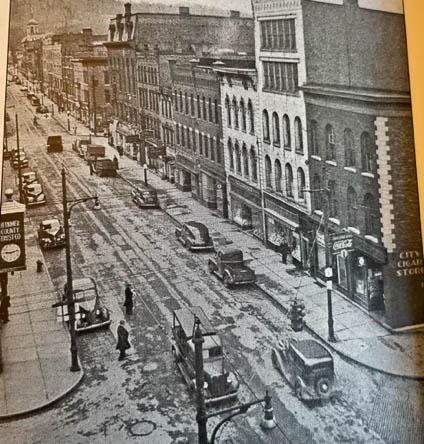
A good look at the south side of Main Street (photo from the 1930s) from the City Cigar Store on the corner of Main Street and Ann Street, to City Hall, seen in the distance, on the corner of Main Street and William Street.
As was true in Chicago, Philadelphia, New York City and throughout our cities in this era, the Jewish merchants were in the forefront in the operation of successful retail businesses. They were the cornerstone of that retail and wholesale merchant business in the United States. The Main Street of Little Falls, N.Y. was synonymous with the other American main streets of the time. Consequently, we owe much of the development and success of the formal Main Street shopping district in Little Falls to those early local Jewish families who determined to invest in, and thus facilitate, Main Street’s growth and prosperity during those years.
Many of the early Jewish family owners remained during the 1955 to 1965 window of our article. Names like Volgel, Wolf, Lovenheim, three brothers, Al, Morris, and Bill Goldstein, Glockman, Chesler, Feldman, Smallen, Nast, Solomon, Lurie, Blumberg, Rudolph and others anchored the men’s, women’s and children’s clothing, hardware, jewelry and furniture businesses.
Those familiar with this era of our Main Street, will recall many of the stores and businesses that filled our busy thoroughfare. Those not familiar with that era will likely be surprised as to the extensive list of merchants and professionals, as well as the volume of commerce, that was conducted between William and Furnace Streets. No big box store chains like Kmart or Wal- mart in other communities were competing with our Main Street businesses. We had all of the goods anyone needed on our Main Street. It was a treat to head to Utica for a purchase now and then, but the great bulk of our citizen’s expendable purchasing power was spent here in Little Falls. The merchants filled our local newspaper, The Little Falls Evening Times, and the airwaves of radio station WLFH, with all kinds of sales advertisements. During the holidays, it was common to see long lines at the cash registers, customers coming from both the local and surrounding communities, often requiring businesses to hire extra help to keep up with the demand of shoppers. Main Street was booming.
Polk’s 1957 Little Falls Directory
The Polk’s 1957 Little Falls Directory lists all the Main Street businesses and it is impressive to see the businesses listed solely in the Burrell Building (currently the Adirondack Bank location) at 500 Main St. The bank in the Burrell Building at that time was The Herkimer County Trust Company. In 1957 eleven independent attorney firms had offices on the upper floors of the five story Burrell Building to include, Santry, McCarthy, James McTiernan, John McTiernan, Zoller, Bronner and Ward, James Bronner, Marion, Fiesinger, Scalise, and Malone. Two medical doctors, Newton and Stern, two dentists, Ball and Sullivan, and the Davy Dental Laboratory, three notaries, Clark, Paul and Riseley, four insurance entities, Rogers and Ashe, Travelers, Mass Mutual and Fidelity & Casualty, an investment firm named Nellis Bronner, Little Falls Optical, a watch repairer William Barnes, two beauty shops Lena’s and Helen’s, the American Red Cross, and all anchored by the Herkimer County Trust. All housed in that one building. One can imagine the foot traffic you would run into in the lobby. The lone elevator in the lobby was run by an attendant who greeted you as he opened the heavy criss-crossed iron gate, requested your floor, manually closed the scissor gate, and delivered you to your destination.
As the extensive list with this article shows, you really could find everything you might need on Main Street. You could bowl at the Hippodrome Bowling Alleys on the 2nd floor over Lurie’s Department store, have a malted shake at Clemens Drug Store, buy a new or used Plymouth, DeSoto, or Studebaker at one of four auto dealers, buy your shoes at five different cobbler stores, fill prescriptions among four pharmacy stores, and choose your favorite Cuban from six cigar stores, your pearls from five jewelry stores, your steak and eggs from ten different restaurants, grills and diners, and get your hair styled at four barber shops, and, but of course, seven beauty shops.
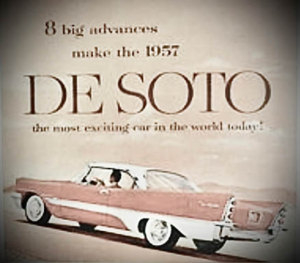
Remember those cool whitewalls!
Some businesses had a run of 30 years or more on Main Street
Some businesses had a run of 30 years or more on Main Street including The White Rose Bakery, The Boston Store, Goldstein’s Men’s Shop, Chi Chi’s, The Style Shop, The Wonder Store,
Bride’s Cigar Store, Lovenheim’s, Herkimer County Trust, Gregorka’s Camera Shop, Ed and Bud’s, Sears Roebuck & Co., Malone Law Office, McCarthy Drugs and Leonard Colangelo, Tailor. These are the entities that come to mind and include the years pertinent to this article. I’m sure there are many more that elude my recollection.
A friend, Joe DeLorenzo, had a musical perspective on our Main Street. Joe is an accomplished musician, plays several instruments, including the accordion and piano, and was the conductor of a well-received local big band called the Second Time Around Big Band. Joe is also a Professor Emeritus of Herkimer Community College where he oversaw the music program. Joe’s godparents, Florence and Salvi Ferraro operated Salvi’s Music Store on Main Street. Musical instruments of all kinds were displayed in the big front windows. Inside, pianos, other instruments, music stands, music cases and hi-fi sets lined the walls. Salvi, also the Little Falls Military Band conductor, could play most of those instruments. The store was also filled with teens picking through the stacks of vinyl in search of their favorite record at the time, perhaps Elvis, Frank Sinatra, Doris Day, Nat King Cole or Dean Martin. As for me, I started buying a little later, when the Beach Boys, The Four Tops, The Beatles and The Dave Clark Five were at the top of the charts. Joe remembered that you were actually allowed to listen to the record before deciding to buy it. He credits the day Florence gifted him an LP record by Doris Day called ‘Love Me or Leave Me’ with nurturing his love of music as a young boy. Joe said he “wore the record out’”, which included hit songs “You Made Me Love You”, “Everybody Loves my Baby”, and “I’ll Never Stop Loving You.” Doris and Florence became the catalyst for Joe’s dream to be a musician. Without them he may not have become the multi-talented musician he is today. Many other talented Little Falls music students also got their start at the incomparable Salvi’s School of Music.
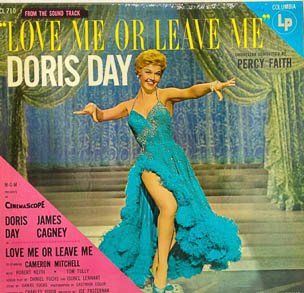
“I wore the record out!”
Salvi’s School of Music
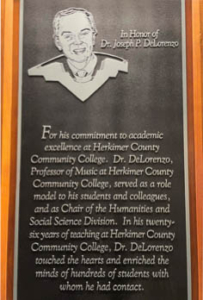 Salvi’s School of Music was located on the second floor over Salvi’s Music Store. Scores of young music students trudged up the stairs and joined instructor Don Musella, Olga Krchniak, or Mr. Gray and others for a half-hour of serious private music lessons. I was one of those students who learned to play the trumpet in one of those cubicles. Joe DeLorenzo took accordion lessons. My sister Kathy took guitar lessons. Many students walked back down those stairs as accomplished musicians and filled the seats of the Little Falls Symphony Orchestra or Military Band. Others, like Joe, made a music career out of those years of lessons in those small cubicles.
Salvi’s School of Music was located on the second floor over Salvi’s Music Store. Scores of young music students trudged up the stairs and joined instructor Don Musella, Olga Krchniak, or Mr. Gray and others for a half-hour of serious private music lessons. I was one of those students who learned to play the trumpet in one of those cubicles. Joe DeLorenzo took accordion lessons. My sister Kathy took guitar lessons. Many students walked back down those stairs as accomplished musicians and filled the seats of the Little Falls Symphony Orchestra or Military Band. Others, like Joe, made a music career out of those years of lessons in those small cubicles.
J. C. Penny Department Store
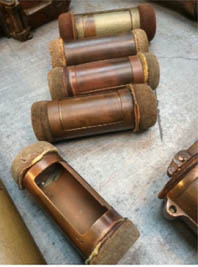
The traveling pneumatic tube system was the pinnacle of technology when the design was first introduced.
The J. C. Penny Department Store was one of the busiest stores in Little Falls. It had two floors of retail space and never had a shortage of clerks to wait on you. A unique distinction of the Penny’s store (and Lurie’s Dept. Store) was the use of pneumatic tubes. The pneumatic tubes were systems that propelled cylindrical containers through networks of tubes using compressed air or by partial vacuum. Cash was taken by the clerk, and with the sales transaction tape, was placed in the tube. A characteristic “thwunking” sound was made as the tubes took off via tubing hanging from the ceiling. It was routed to a clerk upstairs in an office, who would make the correct change, put it in the cylinder, and send it “thwunking” back downstairs So,one person, instead of seven, handled all of the cash transactions. Anyone who remembers shopping at the Pennys’ store remembers the “thwunking.”
Women’s clothing stores on Main Street
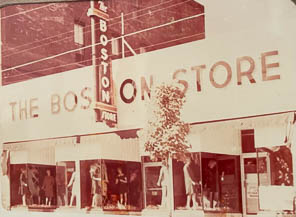
My mom and dad operated the Boston Store for many years.
Shop in any of the women’s clothing stores on Main Street, The Style Shop, The Boston Store, The Strand, Smallens, Chi-Chi’s, or Stewart’s, and you could layaway clothing, with the item being held, while you made regular cash payments over time. That was quite common. What was not common was the offer to take home your choice of clothing “on approval”, try them on, bring the clothes back, and pay for what clothing you decided to take. How’s that for trust? Everyone knew their customers. Everyone trusted and “approved” of their customers. Try that one today…
No one growing up during this time will ever forget Kandyland. It’s the iconic memory of all folks growing up in Little Falls in this era.
Kandyland! How tempting, how inviting was that name for a young child? Kandyland was an old-fashioned ice cream parlor, with homemade ice cream, burgers and fries, and, of course, homemade chocolate candy. Mary Ann Mucica wrote a wonderful article about our Kandyland in a 2009 article in the Times Telegram:
“In the mid-1950s through 1969 the store was owned by Peter and Dorothy Gregory of Little Falls. It served as the place to go for lunch and as an after-school gathering spot for all the young people in town. After every basketball or football game, the booths were loaded with school children, affording some competition to The Favorite Food Restaurant, owned by Olga Yaworski, and of course, “Skippy’s.” As you walked inside on the black and white tiled floor, to your right was the lunch bar, complete with marble counters and round bar stools where you could sit and just stare into the mirrors that reflected all the beautiful glassware from banana split dishes, small portion ice cream dishes, tall sundae dishes for those hot fudge, caramel, butterscotch or marshmallow sundaes.” I remember the wooden booths in the back where the upper class students would hold court (and maybe puff on their first cigarette). Perhaps it was the continuation of a date after seeing a movie at the RialtoTheatre a block away that brought you to Kandyland. Maybe it was your first date, to share a milkshake and fries and a cherry coke. Whatever the reason, it was the legendary teenage hangout in the 50s and 60s, certainly the happy days of our youth. Richie Cunningham, Fonzie, Potsie and Ralph (of “Happy Days” fame) along with Laverne and Shirley would have certainly hung out there.
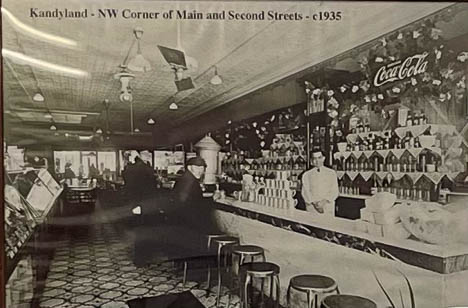
Sunday Monday Happy Days, Tuesday, Wednesday, Happy Days, Thursday Friday Happy Days, Saturday, what a day, Groovin’ all week with you!
We all dropped off film at Gregorka’s Camera Shop to have it developed. A foreign concept indeed to our youngest generations. Oh what a joy it was to pick up our developed photos a few days later and open that special envelope and actually get to see those photos. No mobile phone editing to include coloring, highlighting, red eye reduction or tinting allowed. I believe the term “what you see is what you got” may have been coined for this moment. Most of the results turned out just fine, however some of the results may not have been what you were hoping for. Hopefully Aunt Vivian’s colorful and bountiful Sunday Easter Bonnet was not accidentally cropped off.
Lifetime friend and Little Falls native, Roger Klimek, recalls this amusing story. He looked back on a day after playing sandlot baseball at the Church Street ball field and relished a visit to Paul’s Cigar store on West Main Street, carrying his baseball glove with him. Paul’s was located kitty corner from the post office near the corner of West Main and School Street. Paul’s stocked cigarettes and cigars and candy of all kinds but his specialty was his popcorn. Roger remembered “the store held powerful fragrances of the freshly popped corn with a heady blend of other scents – bubble gum, Hershey chocolate bars, Chunky bars, wax lips, wax noses, and candy dot ribbons!”
He reminisced, “We’d go down to Paul’s after playing baseball at Church Street. field, and we’d all order popcorn. Every time we’d say “lotsa budda” Paul would repeat our orders, “lotsa budda”, while pouring that golden butter over the popcorn. What a great sight! The butter would soak through the bag. I’d use the buttery bag and my buttery hands to rub that nectar into my leather baseball glove! To this day my glove still exists in buttery good shape. Thanks to Paul’s “extra budda.”
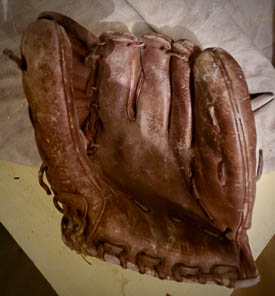
Little Falls Little League All Star Roger Klimek’s well preserved glove.
A special treat as a child that became a cherished memory of mine as an adult, was walking past the little clock and watch repair shop. It was housed in the below-ground level space to the right, or east of, the main entrance door to the then Herkimer County Trust Company in the Burrell Building. It was owned by William Barnes, and was known as William E. Barnes Watch Repair. It was a tiny little shop that fascinated me as a child. The shop had a full width window at the sidewalk level and, as the shop itself sat below the sidewalk level, you looked down into the shop as you strolled past. It was full of clocks and watches of all kinds, but it was the many cuckoo clocks that enchanted me as I pressed my nose to the window. They are known for their distinctive feature of a “cuckoo” bird that pops out of a small door on the clock face and cuckoos the time every hour. Cuckoo clocks are usually made from wood and have intricate carvings and paintings on the exterior. The movement of the various intricately carved cuckoo birds, or miniaturized people or animals, marched to the beat of their own bird calls and whistles. The whirring of wheels and springs and drums and cylinders was magical to a young boy. I remember looking down and seeing the elderly proprietor, with tiny metal parts spread out on his bench, wearing a green visor and silver eyepiece and employing miniaturized tools to fas- tidiously repair a treasured watch piece. The sight gave me a warm feeling as I envisioned the proprietor to be a kindly Geppetto-like character. To this day when I walk past that long vacant tiny space, I smile and think of Mr. Barnes bringing back to life one his customer’s prized watches.
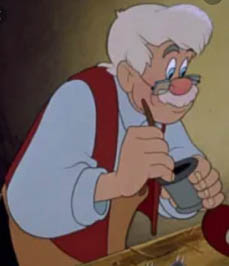
“Mr. Barnes at work.”
Main Street and State Route 5
Main Street was also State Route 5 and carried travelers east or west on their way to other destinations after traveling directly through our Main Street. There was no arterial allowing traffic to skirt around Main Street. All traffic flowed along Main Street. Add to that the amount of local commerce being done, the two way traffic pattern, and the “double parking” by delivery trucks delivering clothing, appliances, jewelry, giftware, flowers, ice cream, stationery, hardware, comic books, musical instruments, barber supplies, candy, cigars, cigarettes, milk, restaurant supplies, you name it, and a congestion nightmare occurred daily on Main Street. The honking symphony of Ford, Chevy and Chrysler horns, failed to dislodge the gridlock.
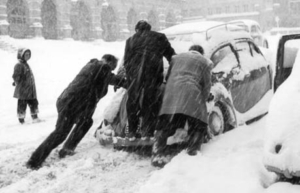
Friends and neighbors would help push cars stuck in the heavy snow.
Winter on Main Street during this era brings memories of snow clogged streets, and cars stuck in snow as snowplows and snow tires were not quite up to today’s standards. The snowbanks were not cut back in those days and the season’s snow falls just kept piling up on the snowbanks. Is it just me and the aging process, or were winters in my youth much more severe in the 1950s and 60s than they are today?

Remember the jingle jingle!?!
Cars actually had chains attached to their tires to help with traction in the snow and our many hills. The background jingle jingle sound of those chains was synonymous with the winter and holiday season on Main Street.
Every store front had their windows decorated for the Christmas season and the snow topped lamp posts were decorated as well. Store proprietors, in pre-canopy days, kept the sidewalks shoveled and salted, ready for the onslaught of shoppers with their long lists. Those shoppers were serenaded by classic holiday melodies cascading from the loudspeakers on our Main Street. Music that would brighten your spirits, gladden your mood and put a smile on your face. “White Christmas”, “Silent Night” and Rockin’ Around the Christmas Tree” were in the background of every holiday step we took. Memories are intricately entwined with music, and especially beautiful and emotional Christmas music. These connections are one of the reasons why “It’s the Most Wonderful Time of the Year.”
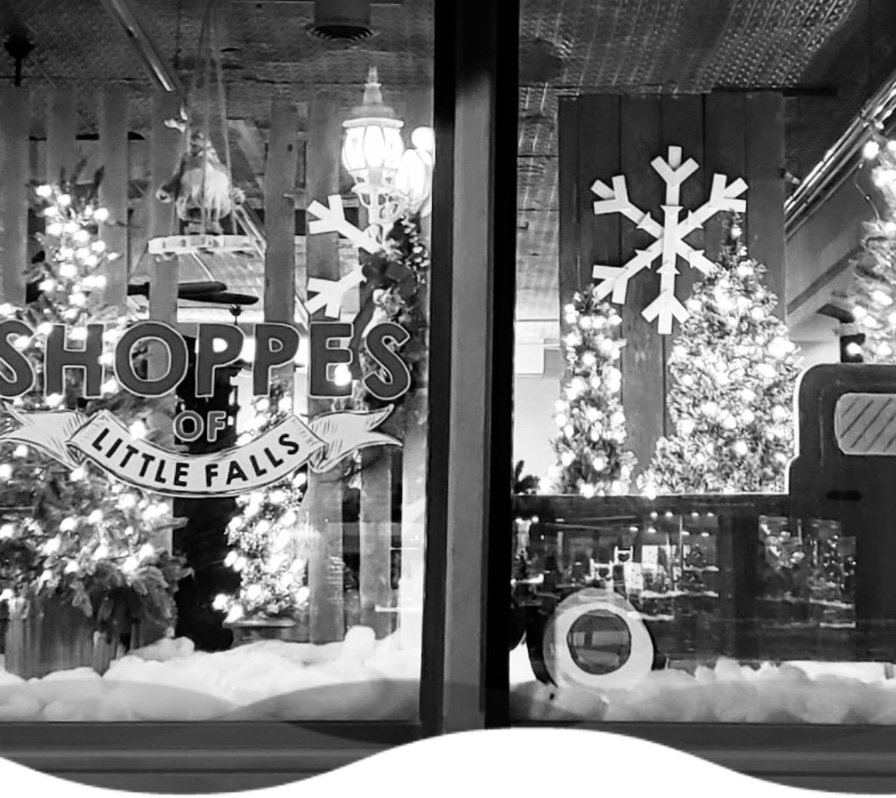
Shoppes of Little Falls
The Little Falls Marching Band
Donald Musella, the young band leader at the Little Falls High School during this era brought the entire music department to a new level with his dedication and talent. The Little Falls Marching Band was a source of pride for the community as it was recognized year after year with awards at band competitions. So when the high school band participated in parades the citizens came out and lined Main Street to watch. One annual parade in particular stands out in my memory. Our annual Little Falls Thanksgiving Day parade, which kicked off the holiday season and introduced Santa to the kids, was very popular. One year the temperatures dropped into the mid 30s. I and 40 strong wore the smart looking purple and white wool uniform and matching hat (many of us wearing long underwear to keep from freezing) and polished white buck shoes. Valves on my trumpet, and all of the brass instruments, became sluggish in the cold, and the silver coated brass mouthpieces stuck to our lips. Our joyous holiday music that we practiced to perfection, “Joy to the World”, “Jingle Bells” and “Here Comes Santa Claus” was unrecognizable. Our band was no longer producing a pleasing cohesive holiday sound as valves stuck and lips froze producing a cacophony of screeches and squeals. Soon thereafter, the cold weather Thanksgiving Day Parade down our Main Street was a thing of the past.
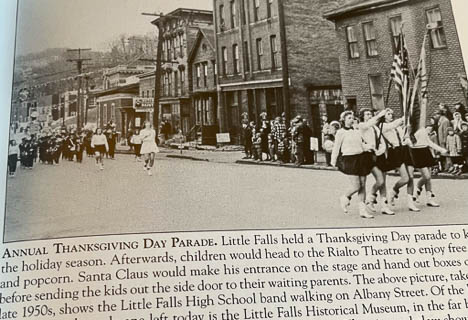
Annual Thanksgiving Day Parade
Main Street was a place of commerce for sure, but it also became a place of celebration.
Main Street turned into what could have been renamed, Patriot Way, as it became the venue to honor and thank those servicemen who had fought in and survived WWII and the Korean War. We remembered the service and sacrifice of all those that had defended our freedoms and protected our way of life. America’s main streets owed a gratitude of debt to these brave combatants and provided the marching grounds for many annual parades. Little Falls citizens and those from surrounding communities came out annually in the thousands to show their love and respect for these marching heroes. Remember, five and six story buildings lined both sides of main street and all of the upper apartments were full of tenants. They had the best views (the 50 yard line seats) and hundreds would be leaning out of their windows cheering on the parade.
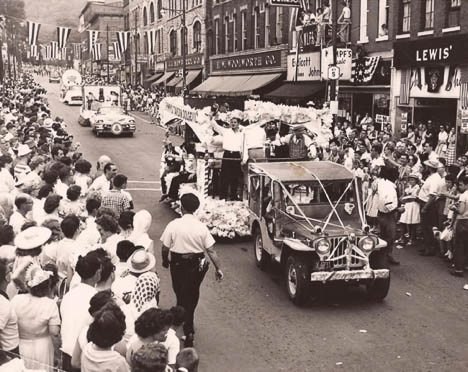
The crowds came out for the Little Falls’ parades.
So the buntings came out, the flags waved everywhere, and the cheers reverberated among the buildings lining our Main Street for those proud marching veterans. The bands played the military theme songs of the Army, Navy, Marines and Air Force, and confetti fell on the partici- pants. Deep patriotic feelings were likely at an all time high. Everyone quieted, took off their hat and raised their hand to their heart as the American flag went by. And so it was, yearly on our Main Street in the 1950s. A community coming together on Main Street, celebrating our hard won freedom, and showing their admiration for America’s heroes. My dad, Army Master Sergeant Stanley Kazmerski was one of those heroes. Respect for America’s military was at its height. To this day, whenever I hear any of the military marching songs, “Anchors Aweigh, “Marines Hymn”, “The Air Force Song”, or “The Army Goes Rolling Along” I get a lump in my throat and a tear in my eye.
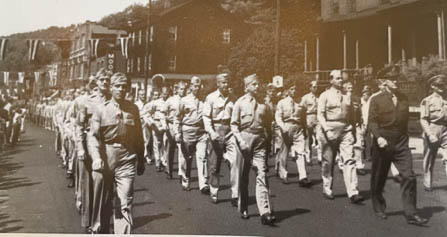
To the strains of “the Army goes Rolling Along”, Little Falls heroes marching down Main Street.
U. S. Army Military supply convoys
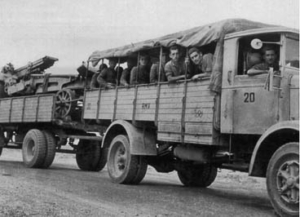
“The Caissons go Rolling Along”
Our Main Street became part of the route that the U. S. Army Military supply convoys took to Pine Camp (later renamed Camp Drum and later Fort Drum), and it always drew a crowd. Veterans saluted and kids waved, hooted and hollered and would run for blocks keeping up with the military might, as the Army personnel waved back. The caravan arrived from the east on Route 5, down our Main Street, north on Ann Street, and west on Church Street, or Monroe Street to what was called the Gateway to the North, NY Route 169, and eventually to Pine Camp. A dozen jeeps, followed by armored cars, howitzer cannons, cargo trucks, personnel carriers, command vehicles, mortar carriers, and half-track armored personnel carriers paraded through town, all covered in the Army olive drab camouflage, with large white stars emblazoned on the doors. These military convoys happened several times a year through out this era, and was a powerful reminder that the US military was ready and able to keep our country safe.
Those little kids that ran down our Main Street after those camouflaged caravans – well, little did they know that some of them would be running, a decade later, in the jungles of Vietnam; in those olive drab uniforms. Some would never see our Main Street again. To those that served, thank you for your service in protecting America, and her Main Streets.
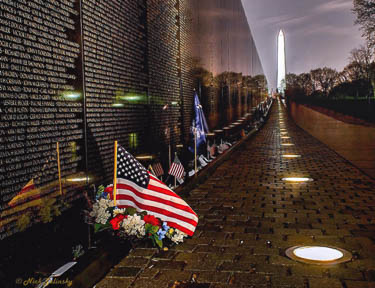
The Wall, the national monument in Washington, D.C., honoring the over 58,000 members of the U.S. armed forces, including Little Falls citizens, who served and died in the Vietnam War. They include: Cpl. Donald Allen Coffin SSgt. Joseph Stanley Zawtocki Jr.
Bars and Billiards
It was well known, or a well-known boast at least, that Little Falls, in this era, had the greatest number of bars per capita than any other city in the state. Main Street had its share with Walt’s, Walnut Grill, Ed & Bud’s, Millie’s Restaurant & Grill, The Corner Tavern, Hotel Snyder Tavern and Eddie’s Tavern with a dozen more on the side streets just off Main Street.
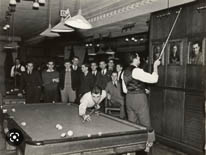
“Hey, I thought you never played this game before…”
It was also well known that Little Falls, in the era described, had a large contingent of talented youths who could start as varsity billiard players on any school team in the state. If they only had billiard teams. Many would have received straight A’s at the pool academy (as we called them) of their choice (the only A’s some of those talented boys ever got). That “A” standard was achieved due to the plethora of pool/billiard establishments in Little Falls. Mike Walo and Jeff Gressler wrote an all encompassing and wonderfully nostalgic article for the Little Falls Historical Society writing series entitled “Little Falls Pool Halls – Reflections on a By gone Era”. Be sure to read it. The Main Street of Little Falls had three such pool academies to help nurture their student’s desire to be better in “English”, masse and banking (and hustling). Those Main Street academies were Wally’s, City Cigar Store and Bride’s. I was inspired by Mike and Jeff’s article and memories of long ago came flooding back of our studies at Bride’s Academy. The sound of those muted colored balls clicking off each other dominated the atmosphere for sure, but the respectful way in which we played was also a part of that atmosphere. The Bride brothers kept the order under their watchful stares, and even when the place was full the voices were also muted, and the focus was on the game. Of course it was the young male voice that was heard, no females allowed, an informal boys club it was. Another sound etched in my memory was when we reached up with our cue sticks to move the wooden stained black and tan scoring beads zipping along the wire. Every multiple of 10 would have a bigger black bead that hung down and every once in a while someone would reach up with the cue stick and smack the 10 or 20 bead to simply spin it around. The smooth green colored felt had a distinct feel as you slid your hand across to set up your bridge. The smooth tan maple wood shaft of the cue lay loosely in your fingers as you deliberated your next shot, always thinking ball placement for your following shot. The better players thinking two or three or more shots ahead. Maybe your cue ball was stuck against the rail and your eye noticed the inlaid diamond marker glittering in the side rail. Then there’s the blue chalk used for increasing friction and softening the blow from your felt tipped cue, helping to avoid the disastrous and embarrassing “miscue.” If you failed to wash your hands thoroughly, the blue tell would be a sign to your parents that you were in “a place of ill repute”, where one inevitably would be led down a path to moral decay and academic anemia. Where this urban myth was born and based on was not clear, but parents of all teens embraced it. Our grades did not necessarily suffer due to attend- ing Bride’s Academy, but we sure did develop a skill set that would last a lifetime. The mental stimulus provided in a competitive straight points game to 50 employed steely concentration, strategy, problem solving, the study of tangent lines and physics, and developed excellenthand eye coordination. Not to mention many devotees developed into crack pool players and we took such skills to college and, importantly, ruled the rec (recreation) rooms. Of course time management skills came into play as we needed to beat it back to the first bell at high school “after lunch.” The high slatted back spectator chairs that lined the one wall gave us a good view of our op- ponents skill. Sure would be nice to have one of those now. For an investment of a penny a minute, it has had quite a return in value. Who knew then that that time and atmosphere and camaraderie would be so rich and meaningful? Thanks, Bill and Les Bride, for the memories.
Urban Renewal
1965 was the beginning of the end of the “Golden Era” of our Main Street as this article describes it. Urban Renewal became a national progressive mantra, and the little city of Little Falls, for good or for bad, was caught in its crosshairs. Urban Renewal has been defined as “the clearing out of blighted areas in inner cities to eliminate slums and create opportunities for higher class housing, businesses, and other developments.” According to Louie Baum’s excellent slide presentation for the Little Falls Historical Society entitled “Urban Renewal Presentation”, the Phase I “project took out the south side of Main Street as well as Albany Street, and the south side of the city. Hundreds of housing units and other structures were demolished, displacing several thousand people and more than 100 businesses. Phase 2 of Urban Renewal in Little Falls saw the demolition of another 48 housing units and 39 businesses..” There were some dilapidated buildings for sure. However the population of Little Falls subsequently decreased because of the housing loss and the tax base was significantly reduced. Refer to Louie Baum’s slide show for more data on the significant reduction in assessed evaluation and losses of housing and people. In Phase 1, the vacant area was replaced with a modern one story strip mall called Shoppers Square with space for approximately 30 businesses and a modern 2 story bank building to house the Herkimer County Trust Co. (currently the M&T Bank location). To supplement the housing, Valley View Courts with 96 apartments and the nine-story Rockton Plaza, with 64 units were built. Less than a decade later the Urban Renewal fervor fell out of favor, the wrecking ball was mothballed for a new national mantra. The better idea, according to CQ Researcher, was, “conservation and rehabilitation of existing structures, resorting only to spot demolition where necessary.” Whether the urban renewal project in Little Falls was a success or a misstep can be debated in other essays.
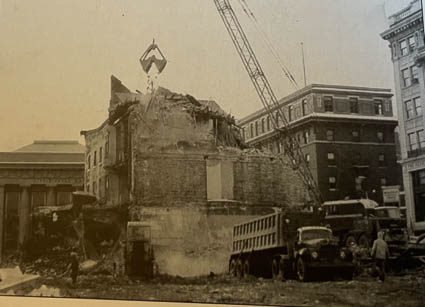
The wrecking ball takes down the southeast corner of Main Street and Ann Street.
***Please be sure to see the Little Falls Historical Society Old Bank Building Museum’s exhibit featuring a pre-urban renewal version of the Little Falls commercial district.
A second reason for the decline in Main Street commerce was the 1969 decision to re-route traffic away from Main Street so that all “through” traffic could skirt around our Main Street and business section. It solved the “congestion” on Main Street. The source of the “congestion” never did spend another dime for a cup of coffee, hamburger, newspaper, coke, flowers or a gift for a wife or grandchild again. They bought those items somewhere else, and not on our Main Street. But, we were certainly less congested.
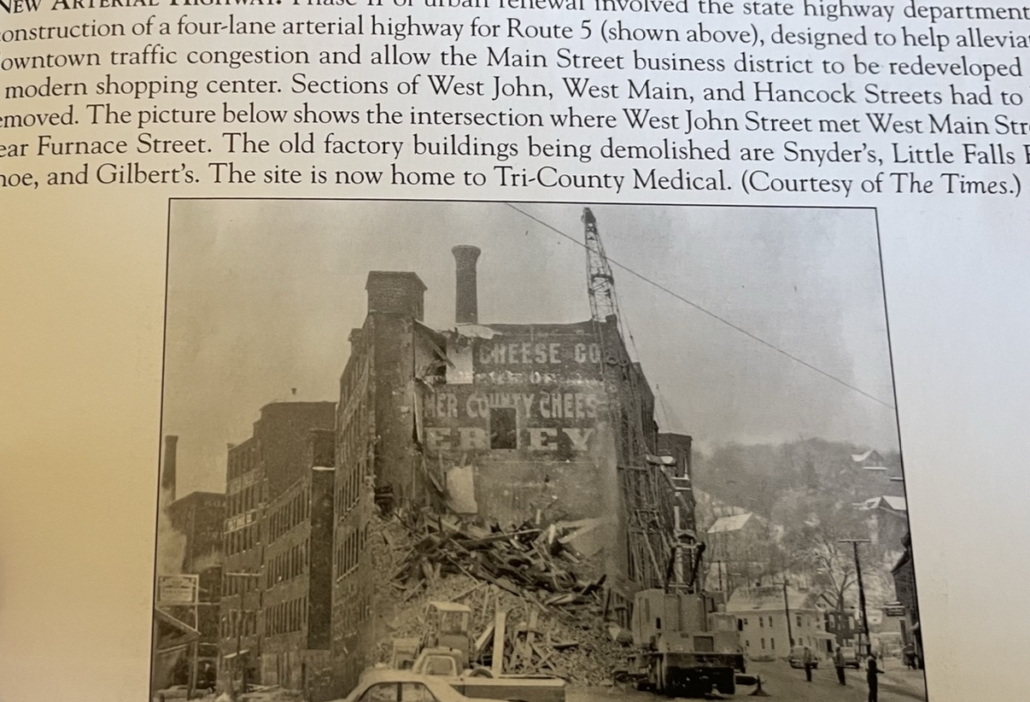
Making room for the EW Arterial.
The third reason for the decline of business on Main Street was the early 1970s relocation of the local high school from the downtown Benton Hall building on East Main street to a new facility on the outskirts of our city. While located at Benton Hall, the majority of the students walked to school and many walked Main Street, balancing their algebra and chemistry books, gym bags, trumpets or trombones. They ate lunch, bought clothes, candy, gifts, cards, jewelry, bubblegum, shoes and played pool. While the new high school provided the much needed facility upgrades, another stream of potential business was removed from our Main St., further reducing the roar of the Main Street economic engine.
That’s not to say business was not good for the remaining businesses on the north side of Main Street. Much of the competition was eliminated, so the remaining businesses got a much bigger slice of the pie. So the 1970s and 1980s remained profitable despite the dwindling population. Little Falls however, had seen the end of its “Golden Era” of commerce.
In retrospect, flourishing small town main streets in the 1950s and 60s had a sense of community and small-town charm which often seems lacking in today’s more commercialized malls and impersonal retail environments. We, who lived during this time, wish everyone could have experienced our Main Street, as we remember it.
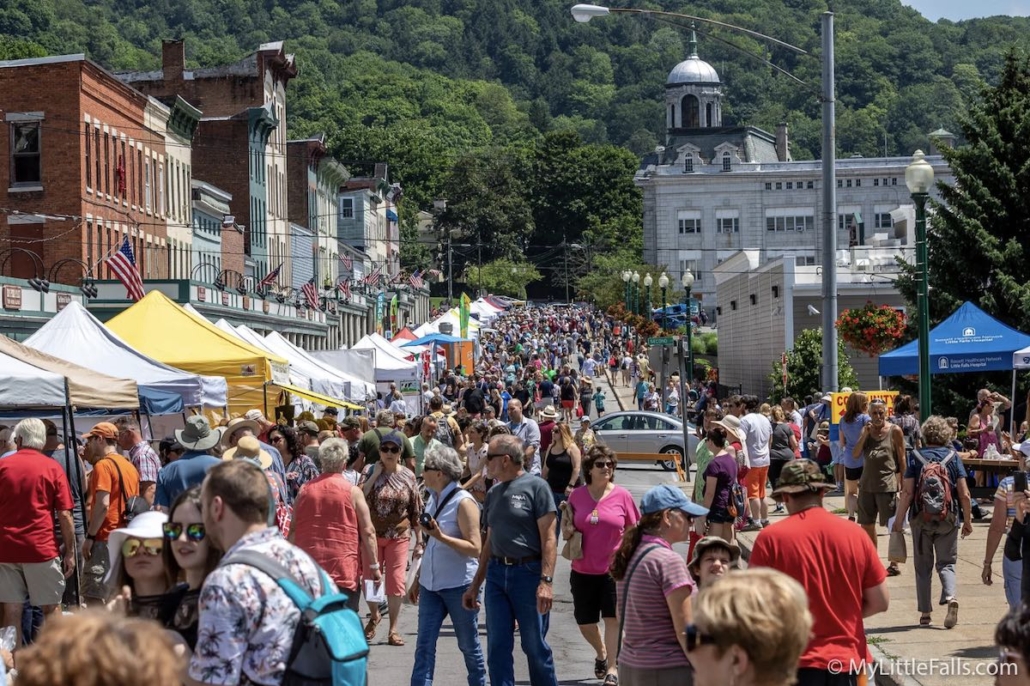
The Little Falls Cheese Festival, the premier cheese festival in New York State.
As I finished writing this essay, I read a current article announcing the projects that had been selected for the current 2022 Downtown Revitalization Initiative. Included is the replacement of the iconic Main St. canopy, redesigning the traffic flow, adding bike lanes, renovation of the M&T building to create downtown housing, and a downtown Little Falls Fund to support small business development. These projects are a sign of confidence in our old Main Street. Our city owes a great debt of gratitude to those leaders, homegrown benefactors, organizations and scores of volunteers that have infused positive energy, vibrancy and a passion into rebuilding our old city by successfully promoting tourism. Due to the success of the Canal Days, Garlic & Herb Festival, Bluegrass, Brews & BBQ, Halloween, Smartphone Film, Christmas, Mid-Summer Night, Art Walk, and Cheese festivals that permeate throughout each year, tourism is now a major factor in the future of our city. Perhaps heralding a renaissance and ushering in a new “Golden Era,” on Main Street.
My dad was put out of business when the wrecking ball took the buildings on Albany Street. The Urban Renewal project was devastating for him. He owned Stan’s News & Variety Store, where he worked for 16 years, putting in 70 plus hours every week building up his business.
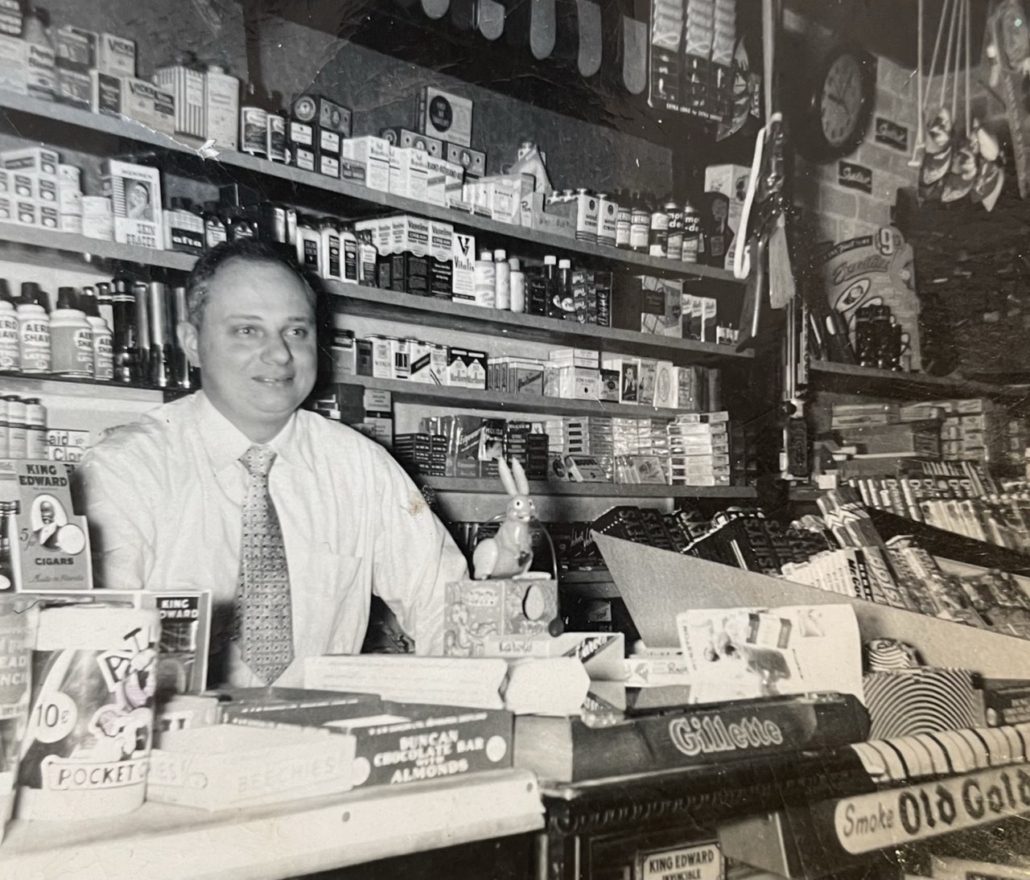
My dad, a Little Falls businessman.
When he found himself out of a job, he then worked odd jobs, but always kept an eye out for another business. When Smallen’s Dress Shop, and subsequently The Boston Store became available, he believed in Main Street, and he and my mom bought those stores. He reclaimed his passion, being a businessman, this time on Main Street. A Main Street where he once had to hold onto his mother’s hand so he wouldn’t be lost in the crowd.
Allen Kazmerski is a member of the Little Falls Historical Society.
Businesses on the north side of East Main Street (after the Burrell Building)
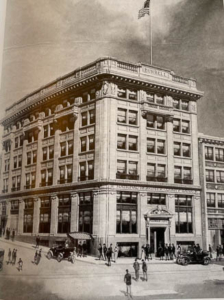
The busy Burrell Building opened in1917.
North side from Ann St to Second Street:
- J C Penney Department Store
- The Style Shop & Bachy’s Shoes (women’s)
- Upstate Loan Company
- Walach’s Men & Boy’s Shop
- Coat’s Drug Store
- Adam Pereske, Dentist
- Wagoner’s Shoe Store
- Firminio Marocco, Tailor
- Trask Cigar Store
- Orval C Hall, Gas Station & Taxi
North side from Second St. to Mary Street:
- National Army Stores
- Patsy Lamanna, Barber
- George J. Morotti, Watch Maker
- Fred D. McIntosh, law, real estate & Insurance
- Kandyland
- Gregorka Camera Shop
- Gregorka Photo Service
- Dresher Furniture Company
- Dockerty Florist
- Earle J McCarthy Drugs
- Levee’s Jewelry Store
- Allen E Levee, Optometrist
- Salvi’s Music Store
- Falls Dry Cleaners
- Flint and Carpinetti, Barbers
- The Strand Store (women’s clothing)
- Goldstein’s Clothing (mens)
- The Boston Store (women’s clothing) Bride’s Cigar Store
- Gregorin’s Refrigeration Montgomery Ward & Company
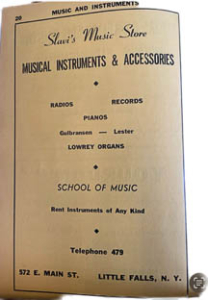
North side from Mary Street to William:
- Comstock’s Hardware
- Harrison’s Jewelry Store
- Carl J. Kopp, Insurance & Real Estate
- Stewart’s Men & Boy’s Shop
- R K Casadonte, Heating & Air Conditioning
- McTiernan Electric Company
- Hart Bros., Plumbing & Heating
- Smallen’s Women’s Clothing
- Sam’s Smoke Shop
- Chi Chi’s Women’s Wear
This is a list of businesses that existed on the south side of East Main St.
South side from Ann St. to Second Street:
- City Cigar Store Clemens Drug Store
- D. S. Ackerman & Sons, Men’s & Boy’s Clothing
- Little Falls Military Band
- Flavia-Ann Bridal Sho
- Eddie’s Tavern
- L. L. Yourdon’s Men’s Furnishings
- Favorite Food, Restaurant
- Things Shoe Store
- S & S Alteration Shop
- M Lurie & Company, Department Store
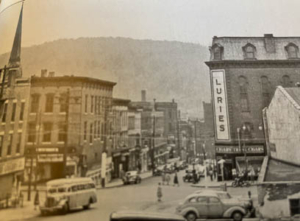
The very popular Lurie’s Dept Store on the corner of Main Street and Second Street
South side from Second Street to Mary Street (note, at that time Mary Street continued south to Albany Street and John St., which is now the EW Arterial):
- Lewis Children Shop
- Harold J DuBois, Jewelry & Gift Shop
- Endicott Johnson Shoe Company
- Peter L Kuzmak, Dentist
- Marianne Beauty Shop
- Little Falls Post 31, American Legion
- Irving L Nightingale, Signs
- F. W. Woolworth & Company (the 5 & 10 store)
- Kempf’s Music Store
- J J Newberry & Company
- Leonard Colangelo, Tailor
- Arlene’s Home of Beauty
- Carl H Hoerz, Optometrist
- Rudolph’s Jewelers
- Puritan Clothing Store (men & women)
- Sears Roebuck & Company
- Wonder Store, Variety Store
- Stewart’s Ladies Apparel
- Ruth Waltamath, Beauty Shop
- Reardon’s Wallpaper & Paints
- Skippy’s Snack Bar
- William G Heron, Liquor Store
- Loblaws Grocery
- Daly’s Drug Store
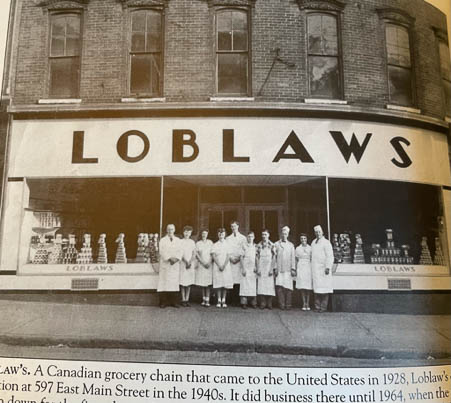
Loblaws. A Canadian grocery chain that came to the United States in 1928.
South side from Mary St., to William St.:
- Western Auto Associate Store
- Miko’s Restaurant and Grill
- National Accessories Stores, Inc.
- Drake Bakery
- Great A& P Tea Company
- Ferdinando Shoe Service
- Old English Cleaners
On to West Main Street, north side, from Ann Street to School Street:
- Hotel Snyder Tavern
- Pauline Hat Shop
- Hotel Snyder
North side from School St. to Furnace St.
- Little Falls Diner
- Bill’s Dinette
- Central Cigar Store (aka Paul’s) Moose Lodge
- Kuyrkendall Sheet Metal Workers
- Spoars Fix It Shop
- MacRorie Motor Sales
- Daniel Nast Hardware
- Central Barber Shop
- Chris Rahm Restaurant
- Ageless Thought Memorials
- ACE Equipment – furniture & Restaurant equipment
- L. F. Lock & Key
- Dunn’s Grill
- Provorse Motor Sales, Inc.
- West End Liquor Store
- Baum Cigar Store
- Petrillose Dry Cleaners
- Josephine Staszko – Groceries & Meats
- Thomas Waldron, Barber
- Custard Bar
- White Rose Bakery
- Imperial Restaurant
- Rex Service Station
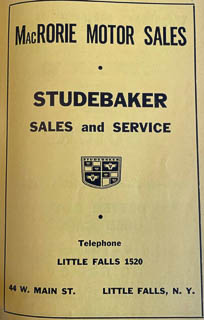
MacRorie Motor Sales
South Side of West Main Street
Note – prior to the construction of the East-West Arterial there were retail stores and housing all along West Main Street to Furnace Street. with 3rd, 4th and 5th Streets running from John Street (the arterial) to West Main Street.
South side from Ann Street. to 3rd Street:
- Little Falls National Bank
- Niagara Mohawk Power Corp
- W. Randall Whitman & Son Insurance
- A. M. Richards Company, office supplies & equip
- Leo D Walsh – Cigars
- Journal & Courier Co.
- Blumberg & Conley, Lawyers
- Elmer Knopf, Sign Painter
- Little Falls Post Office
South side from 3rd St. to 4th St.
- Ross Motors
- Rose Furniture
- Mary Beth Beauty Shop
South side from 4th St., to 5th St.:
- Public Market Groceries
- Arthur Hemstreet- saw fillers & repairers
- Used car lot
South side from 5th St. to Furnace St.:
- Johnny’s Discount Store
- City Launderette
- Walter Brown, General Contractor
- Bradley Sheet Metal Workers
- Little Falls Felt Shoe Company



